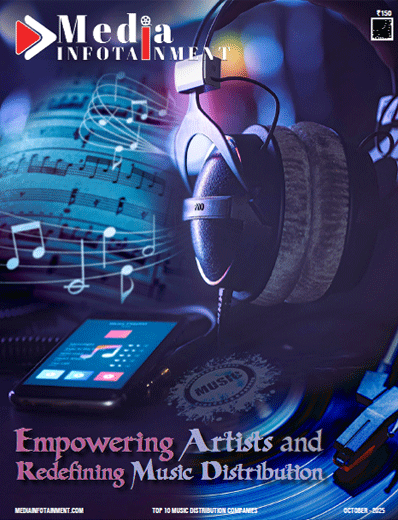Creative Advertisement for New Brands: How to Build Buzz on a Budget
In an exclusive interview with Media Infotainment, Prateek Varma highlights how present-day brands can succeed even with low budgets, by utilizing the channels of social media, and authentic creativity. With innovative tools like AI and data-driven decision-making, Budget is no longer a compulsion for successful storytelling. Prateek is a creative professional with over a decade of experience in the advertising industry. He firmly believes that good creative work stems from people being silly and having fun while creating it. Throughout his journey, he has worked with both teammates and clients who have matched his silliness quotient.
How can emerging brands craft compelling stories that resonate without the backing of big media spends?
Budget is not the most crucial part here. The foremost step is crafting an engaging narrative. To make the narrative engaging, it should be designed around questions such as – What do they stand for? Who do they stand for? Why do they exist? - Once this is nailed, we move to the next step, which is creating your style. Each individual has their own experience, authentic stories and narrative style. Hence, it is important to amalgamate these individual experiences and narratives with audience expectations. When you have a distinct, authentic, and unique style that resonates with your brand’s target audience, you will create communication that will be both entertaining and engaging.
Consider the example of Liquid Death. This brand is not just selling water but killing thirst in a style that is hardcore metal. A product may be simple, but an authentic, unique story for the product is what creates the need among the consumers for it. Similarly, in India, we have The Whole Truth Foods. The founder put his face to the brand, and authenticity as its packaging.
So to create compelling stories without big budgets you need authenticity, distinct style, a true reason to be, and consistency. And you need to mean something to your target audience.
What role does social media virality play in leveling the playing field for brands with limited marketing budgets?
It is a great leveler; I would say. Virality gives you that sudden boost. A power-up I would say. It allows you to grab the attention of your target audience, that too at scale. But virality is not the end goal for a brand. What actions does the brand take to utilize its gained engagement post-viral content becomes more crucial. Since a brand is receiving good attention from its audience, it's important now to create more relevant content, to increase engagement and viewership. This is where consistency becomes a major factor.
In current times, Zomato and Surreal Cereal have been creatively utilizing social media to build the brand.
In what ways can guerrilla marketing and street-level activations build brand awareness in saturated markets?
More ways than one. But most importantly these create interesting experiences that cement the brand in the experiencer’s mind space. Does it have the potential to create a core memory? Yes, especially if it is connected to pop culture. The Nike Air Max Graffiti Stores was successful in doing this. Another example is the Kit Kat bench.
Even in the Indian context, Brands have used The Kumbh Mela to deploy guerilla marketing and activation market. Two of the best examples are- the Nerolac campaign ‘Dukan it Yourself’ where the brand, through its campaign, became part of the event as it celebrated color, creativity, and community collaboration. And the Lifebuoy chapatis - where the soap brand launched a unique campaign called ‘Roti Reminder’, where the phrase ’Did you wash your hands with Lifebuoy?’ was printed on freshly made rotis at the Mela. Through satisfying gratification and creating an experience in pop culture, these brands will remain in the minds of consumers for a long time.
How do newer brands strategically use user-generated content (UGC) to foster trust and amplify visibility at no extra cost?
UGC is all about authenticity and relatability. This shows the customers that the brand is listening to them, fostering brand connections. Brands can use UGC to show themselves in a better light, engage more with their audience, and make customers into brand loyalists. One recent example where a brand used listened and converted UGC to a win would be Tata. When LinkedIn user Shailya Jaggi posted about her car lifting another car and a broken parking elevator, the brand was quick to action.
This becomes crucial, as this not only creates loyal customers but also creates loyal brand ambassadors from mere customers.
READ MORE: The Importance of Storytelling to Build a Reputable Brand
What are some notable examples of low-budget campaigns that went viral and redefined the perception of grassroots branding?
At present, the usage of people holding placards campaigns is more noticeable. It can be individuals or group of people who will be holding placards at high-footfall places. One such brand that made use of this trend and successfully gained attention was the dating app Thursday. It went viral due to its low-budget but high impact. This brand even had someone with a projector and a laptop on a metro train.
When many brands are going for huge budget & routine branding concepts, such low-budget concepts become a breath of fresh air for the audience, facilitating gaining attention. A lot of brands are doing creative stuff with placards in India too, especially at concerts.
How can emerging brands use micro-communities (such as Reddit threads, WhatsApp groups, or niche Facebook pages) to build early buzz?
If you know your audience, and more importantly know what you stand for, this is a good way to create buzz and brand loyalty among your customers. In a world full of choices, having loyalists is the biggest asset a brand can have, and communities provide a sense of being.
One of the best example of such a case is the OnePlus. When OnePlus launched, they had already engaged their core audience and built hype on forums. This combined with limited access made the phone a must-have for tech enthusiasts.
READ MORE: Future Trends in Content Production: How Technology is Shaping Film and Television
How is AI being used by new brands to create personalized, cost-effective ad experiences across platforms?
For low-budget advertisements to work out, the idea has to be creative. This is where AI becomes a good tool, as it facilitates creative thinking. As we are still exploring this innovation, few brands have used the tool to create decent performance assets. AI can take over the laundry list of assets or adapt the performance metrics and e-commerce platforms according to the desired outcome. Hence Ai tools can be a good asset for low-budget ads.
How can data-driven storytelling give a creative edge to new brands operating with minimal budgets?
The market is competitive and large, especially when one is working with a low budget figuring out the direction to attract the audience can become difficult. Hence storytelling on data derived from market research is crucial. Data gives you directions to surf among the competitors. And that is important when the budget is limited.
The Snicker’s social media campaign gave away discounts on Snickers because they had data telling them when social media is Hungriest. That data allowed them to not just create a campaign but pinpoint its targeting both in terms of audience and time.
As the market becomes more volatile, there are tools and operation methods that have made the creative process for small-budget companies to achieve goals. With innovative tools like AI and data-driven decision-making, Budget is not anymore, a compulsion for successful storytelling.
🍪 Do you like Cookies?
We use cookies to ensure you get the best experience on our website. Read more...






